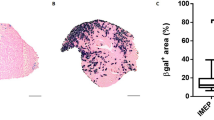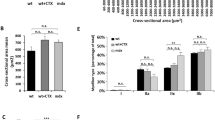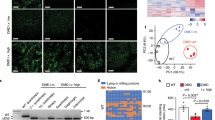Abstract
Duchenne muscular dystrophy (DMD) is a lethal, X-linked, recessive disease caused by a defect in the dystrophin gene. No effective therapy is available. Dystrophin gene transfer to skeletal muscle has been proposed as a treatment for DMD. However, successful treatment for DMD requires restoration of dystrophin in the affected muscle fibers to at least 20% of the normal level. Current gene transfer methods such as intramuscular injection of viral vector or naked DNA can only transfect a small area of muscle, and therefore is of little clinical utility. We have developed a semisystemic method for gene transfer into skeletal muscle of mdx mice, an animal model for DMD. Naked DNA was injected through the tail artery or vein of mice, in which the aorta and the vena cava were clamped at the location just below the kidneys. The DNA solution was thus forced into the blood vessels of both legs. Luciferase gene expression was detected in all muscle groups in both legs. The effects of injection speed, injection volume, and ischemia time on gene expression were also optimized. LacZ staining was used to check the spread of gene expression in muscle. Although the percentage of transfected fibers was modest (∼10%), β-galactosidase was found in all muscle groups of both legs. Finally, plasmid DNA encoding full-length dystrophin gene was injected into mdx mice and widespread restoration of dystrophin protein was observed in all muscles of both hind limbs. In conclusion, these results demonstrate that the semisystemic delivery of naked DNA is a potential approach towards the long-term goal of gene therapy for DMD.
This is a preview of subscription content, access via your institution
Access options
Subscribe to this journal
Receive 12 print issues and online access
$259.00 per year
only $21.58 per issue
Buy this article
- Purchase on Springer Link
- Instant access to full article PDF
Prices may be subject to local taxes which are calculated during checkout










Similar content being viewed by others
References
Hoffman EP, Brown Jr RH, Kunkel LM . Dystrophin: the protein product of the Duchenne muscular dystrophy locus. Cell 1987; 51: 919–928.
Zubrzycka-Gaarn EE et al. The Duchenne muscular dystrophy gene product is localized in sarcolemma of human skeletal muscle. Nature 1988; 333: 466–469.
Campbell KP, Kahl SD . Association of dystrophin and an integral membrane glycoprotein. Nature 1989; 338: 259–262.
Acsadi G et al. Human dystrophin expression in mdx mice after intramuscular injection of DNA constructs [see comments]. Nature 1991; 352: 815–818.
Deconinck N et al. Functional protection of dystrophic mouse (mdx) muscles after adenovirus-mediated transfer of a dystrophin minigene. Proc Natl Acad Sci USA 1996; 93: 3570–3574.
Yang L et al. Adenovirus-mediated dystrophin minigene transfer improves muscle strength in adult dystrophic (MDX) mice. Gene Therapy 1998; 5: 369–379.
Gilbert R et al. Prolonged dystrophin expression and functional correction of mdx mouse muscle following gene transfer with a helper-dependent (gutted) adenovirus-encoding murine dystrophin. Hum Mol Genet 2003; 12: 1287–1299.
Harper SQ et al. Modular flexibility of dystrophin: implications for gene therapy of Duchenne muscular dystrophy. Nat Med 2002; 8: 253–261.
Watchko J et al. Adeno-associated virus vector-mediated minidystrophin gene therapy improves dystrophic muscle contractile function in mdx mice. Hum Gene Ther 2002; 13: 1451–1460.
Mumper RJ et al. Protective interactive noncondensing (PINC) polymers for enhanced plasmid distribution and expression in rat skeletal muscle. J Control Rel 1998; 52: 191–203.
Budker V et al. The efficient expression of intravascularly delivered DNA in rat muscle. Gene Therapy 1998; 5: 272–276.
Zhang G et al. Efficient expression of naked DNA delivered intraarterially to limb muscles of nonhuman primates. Hum Gene Ther 2001; 12: 427–438.
Levy MY et al. Characterization of plasmid DNA transfer into mouse skeletal muscle: evaluation of uptake mechanism, expression and secretion of gene products into blood. Gene Therapy 1996; 3: 201–211.
Wolff JA et al. Long-term persistence of plasmid DNA and foreign gene expression in mouse muscle. Hum Mol Genet 1992; 1: 363–369.
Zelphati O et al. Gene chemistry: functionally and conformationally intact fluorescent plasmid DNA. Hum Gene Ther 1999; 10: 15–24.
Karpati G et al. Dystrophin is expressed in mdx skeletal muscle fibers after normal myoblast implantation. Am J Pathol 1989; 135: 27–32.
Akkaraju GR et al. Herpes simplex virus vector-mediated dystrophin gene transfer and expression in MDX mouse skeletal muscle. J Gene Med 1999; 1: 280–289.
Acsadi G et al. Dystrophin expression in muscles of mdx mice after adenovirus-mediated in vivo gene transfer. Hum Gene Ther 1996; 7: 129–140.
Jani A et al. Generation, validation, and large scale production of adenoviral recombinants with large size inserts such as a 63 kb human dystrophin cDNA. J Virol Methods 1997; 64: 111–124.
Wang B, Li J, Xiao X . Adeno-associated virus vector carrying human minidystrophin genes effectively ameliorates muscular dystrophy in mdx mouse model. Proc Natl Acad Sci USA 2000; 97: 13714–13719.
Yanagihara I et al. Expression of full-length human dystrophin cDNA in mdx mouse muscle by HVJ-liposome injection. Gene Therapy 1996; 3: 549–553.
Feero WG et al. Viral gene delivery to skeletal muscle: insights on maturation-dependent loss of fiber infectivity for adenovirus and herpes simplex type 1 viral vectors. Hum Gene Ther 1997; 8: 371–380.
Krieg AM et al. CpG motifs in bacterial DNA trigger direct B-cell activation. Nature 1995; 374: 546–549.
McMahon JM et al. Inflammatory responses following direct injection of plasmid DNA into skeletal muscle. Gene Therapy 1998; 5: 1283–1290.
Whitmore M, Li S, Huang L . LPD lipopolyplex initiates a potent cytokine response and inhibits tumor growth. Gene Therapy 1999; 6: 1867–1875.
Davis HL et al. Plasmid DNA is superior to viral vectors for direct gene transfer into adult mouse skeletal muscle. Hum Gene Ther 1993; 4: 733–740.
Taylor A, Granger D . The cardiovascular system: microcirculation. In: Renkin E, Michel CC, Geiger SR (eds). Handbook of Physiology, Am. Physiol. Soc.: Bethesda, MD 1984: 467–520.
Cho WK et al. Modulation of Starling forces and muscle fiber maturity permits adenovirus-mediated gene transfer to adult dystrophic (mdx) mice by the intravascular route. Hum Gene Ther 2000; 11: 701–714.
Greelish JP et al. Stable restoration of the sarcoglycan complex in dystrophic muscle perfused with histamine and a recombinant adeno-associated viral vector. Nat Med 1999; 5: 439–443.
Couffinhal T et al. Histochemical staining following LacZ gene transfer underestimates transfection efficiency. Hum Gene Ther 1997; 8: 929–934.
Liang KW, Hoffman EP, Huang L . Targeted delivery of plasmid DNA to myogenic cells via transferrin-conjugated peptide nucleic acid. Mol Ther 2000; 1: 236–243.
Liu F et al. Transfer of full-length Dmd to the diaphragm muscle of Dmd(mdx/mdx) mice through systemic administration of plasmid DNA. Mol Ther 2001; 4: 45–51.
Koenig M, Kunkel LM . Detailed analysis of the repeated domain of dystrophin reveals 4 potential hinge regions that may confer flexibility. J Biol Chem 1990; 265: 4560–4566.
Hoffman EP et al. Somatic reversion/suppression of the mouse mdx phenotype in vivo. J Neurol Sci 1990; 99: 9–25.
Acknowledgements
This work was supported in part by Muscular Dystrophy Association grant and NIH grant PO1 AR45925 (L. Huang) and grant from the Uehara memeriol Foundation (M. Nishikawa). We thank Dr Paula Clemens for providing the dystrophin plasmid and mdx mice. Kenneth W Liang and Makiya Nishikawa were postdoctoral fellows of Duchenne Muscular Dystrophy Research Center, University of Pittsburgh.
Author information
Authors and Affiliations
Rights and permissions
About this article
Cite this article
Liang, K., Nishikawa, M., Liu, F. et al. Restoration of dystrophin expression in mdx mice by intravascular injection of naked DNA containing full-length dystrophin cDNA. Gene Ther 11, 901–908 (2004). https://doi.org/10.1038/sj.gt.3302239
Received:
Accepted:
Published:
Issue Date:
DOI: https://doi.org/10.1038/sj.gt.3302239
Keywords
This article is cited by
-
Intra-arterial Targeted Islet-specific Expression of Sirt1 Protects β Cells From Streptozotocin-induced Apoptosis in Mice
Molecular Therapy (2011)
-
Image-guided, Intravascular Hydrodynamic Gene Delivery to Skeletal Muscle in Pigs
Molecular Therapy (2010)
-
CT-GalNAc transferase overexpression in adult mice is associated with extrasynaptic utrophin in skeletal muscle fibres
Journal of Muscle Research and Cell Motility (2010)
-
Gene Transfer: How Can the Biological Barriers Be Overcome?
The Journal of Membrane Biology (2010)
-
Molecular-Targeted Therapy for Duchenne Muscular Dystrophy
Molecular Diagnosis & Therapy (2008)



